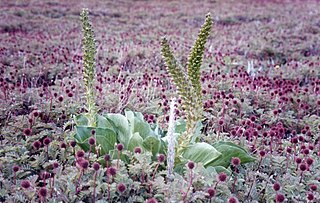
The gentoo penguin is a penguin species in the genus Pygoscelis, most closely related to the Adélie penguin and the chinstrap penguin. The earliest scientific description was made in 1781 by Johann Reinhold Forster with a type locality in the Falkland Islands. The species calls in a variety of ways, but the most frequently heard is a loud trumpeting, which the bird emits with its head thrown back.

The genus Pygoscelis ("rump-legged") contains three living species of penguins collectively known as "brush-tailed penguins".

The Southern Indian Ocean Islands tundra is a tundra ecoregion that includes several subantarctic islands in the southern Indian Ocean.

Ixodes uriae, also known as the seabird tick, is a species of parasitic tick known to infest marine birds. It is native to many high latitude areas in the northern and southern hemispheres including Alaska, Canada, Faroe Islands, Iceland, Greenland, England, Scotland, Norway, Finland, the Kola Peninsula, Russia, Patagonia, South Africa and Australia.
Papua Beach is a beach 1.5 nautical miles (2.8km) long on the southeast shore of Cumberland West Bay, South Georgia. The name derives from "Papua Cove," now an obsolete name, applied for a minor recession of the shore of this beach by the Swedish Antarctic Expedition under Nordenskjold, 1901–04, because a colony of gentoo penguins was found there. The cove was called "Pinguinbucht" on a 1907 chart by A. Szielasko, and the form Penguin Bay appears on some later charts. Following this survey in 1951–52, the SGS reported that the beach now described, rather than the cove or bay, is the significant feature for which a name is required.
Papua Island is a small circular island lying 4 nautical miles (7 km) west of Boreal Point, off the north coast of Joinville Island. The name was applied by the Argentine Antarctic Expedition (1953–54) because large numbers of gentoo penguins were sighted on this island.
Psychrobacter is a genus of Gram-negative, osmotolerant, oxidase-positive, psychrophilic or psychrotolerant, aerobic bacteria which belong to the family Moraxellaceae and the class Gammaproteobacteria. The shape is typically cocci or coccobacilli. Some of those bacteria were isolated from humans and can cause humans infections such as endocarditis and peritonitis. This genus of bacteria is able to grow at temperatures between −10 and 42 °C. Rudi Rossau found through DNA-rRNA hybridization analysis that Psychrobacter belongs to the Moraxellaceae. The first species was described by Juni and Heym. Psychrobacter occur in wide range of moist, cold saline habitats, but they also occur in warm and slightly saline habitats.
Psychrobacter alimentarius is a Gram-negative, non-spore-forming, nonmotile bacterium of the genus Psychrobacter which was isolated from squid jeotgal, a traditional Korean fermented seafood, in South Korea
Psychrobacter aquaticus is a Gram-negative, psychrophilic, halotolerant, nonmotile bacterium of the genus Psychrobacter which was isolated from the McMurdo Dry Valley region of Antarctica.
Psychrobacter aquimaris is a Gram-negative, non-spore-forming, nonmotile bacterium of the genus Psychrobacter which was isolated from the South Sea in Korea.
Psychrobacter arenosus is a Gram-negative, psychrotolerant, aerobic, nonmotile bacterium of the genus Psychrobacter, which was isolated from coastal sea ice and sediment samples of the Sea of Japan.
Psychrobacter fozii is a psychrophilic, oxidase-positive, halotolerant, Gram-negative, nonmotile coccobacillus with a strictly oxidative metabolism, first isolated from Antarctic environments. Its type strain is NF23T.
Psychrobacter frigidicola is a psychrophilic, oxidase-positive, halotolerant, Gram-negative, nonmotile bacterium of the genus Psychrobacter which was isolated from the Antarctic.
Psychrobacter immobilis is a Gram-negative, oxidase- and catalase-positive, psychrotrophic, nonmotile bacterium of the genus Psychrobacter which was isolated from cheese, fish, and processed meat and poultry products.
Psychrobacter luti is a species of bacterium first isolated from Antarctic environments. It is a psychrophilic, oxidase-positive, halotolerant, Gram-negative, nonmotile coccobacillus with a strictly oxidative metabolism. Its type strain is NF11T.
Psychrobacter maritimus is a Gram-negative, aerobic oxidase- and catalase-positive, nonpigmented, non-spore-forming, nonmotile bacterium of the genus Psychrobacter, which was isolated from coastal sea ice and sediments of the Sea of Japan and in Russia.
Psychrobacter phenylpyruvicus is a Gram-negative, catalase- and oxidase-positive, nonmotile bacterium of the genus Psychrobacter, which was isolated from human blood in Belgium. Psychrobacter phenylpyruvicus can cause humans infections such as endocarditis, peritonitis, and fungating lesion of the foot, but those infections caused by this bacterium are rare.
Psychrobacter piscatorii is a Gram-negative, catalase- and oxidase-positive, psychrotolerant, nonmotile bacterium of the genus Psychrobacter, which was isolated from a fish-processing plant. The temperature where Psychrobacter piscatorii was isolated was about 8 °C.

Camilla Nichol is a geologist and museum curator. Since 2014 she is the Chief Executive of the United Kingdom Antarctic Heritage Trust.




